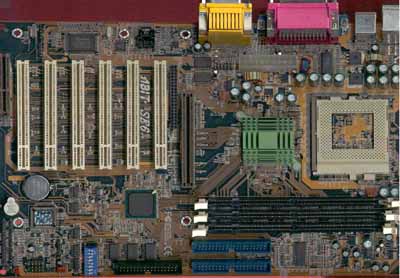Integrated Video Chipset Roundup - January 2001
by Matthew Witheiler on January 10, 2001 4:23 AM EST- Posted in
- Motherboards
Socket370 Solutions: Intel's i815
Intel was one of the first to bring integrated video support to the Socket-370 platform with their i810 chipset solution. Luckily, Intel recently launched the i815 as the i810's successor. Since this chipset offers both integrated video support as well as external AGP 4X support, it found its way into many more systems than the original i810 did.
Intel's i815 chipset is one of the more powerful Socket370 solutions out there when matted with an external AGP 4X video card. The chipset was the first Intel made SDRAM chipset to exploit the 133 MHz front side bus speed while still having an external AGP slot, allowing for much faster system performance. Naturally, the i815 also supports 66MHz and 100MHz front side bus speed. In addition, the 801AA I/O controller hub (effectively the south bridge) mated with the i815 supports Ultra ATA 66/33 as well as 2 USB ports and an AMR slot. There is also the 801BA I/O controller hub which supports Ultra ATA/100, integrated ethernet, CNR, and 4 USB ports.
The integrated graphics on the i815 chipset is the same integrated graphics controller used originally in the i810 northbridge. Intel calls this chip their GMCH, standing for the graphics and memory controller hub. At the heart of the GMCH is a graphics controller that is essentially an i740 accelerator. One thing that the i815 looses from the i810 incarnation of this chip is an option for onboard display cache, meaning that a local frame buffer solution is not available for the i815. Instead, the i815 offers two frame buffer solutions.
The first place that the i815 looks for space for a frame buffer is in what Intel calls a Graphics Performance Accelerator (GPA). This is essentially a 4MB display cache placed on a card that is inserted in the 815 motherboard's AGP 4X slot. This allows the GMCH to look for a frame buffer here, where data is able to pass to and from the GPA at the AGP 4X rate of 1.06GB/s. Although it seems like this is the same amount of memory bandwidth offered by a unified memory architecture with PC133 memory, the GPA does not have to compete with additional data passing over the bus. Since no additional data is passing over the AGP bus, GPA can transfer data at the full 1.06GB/s. This provides much more memory bandwidth for the GMCH when reading and writing to the GPA.
4MB is not a lot of frame buffer, however. When the graphics performance accelerator memory runs out, the graphics and memory controller hub turns to the system memory for additional frame buffer space. This means that once again the data must travel over the already busy memory bus, thus decreasing performance when performing read and write operations on the system memory.
For more information on the i815 chipset, please see our Intel i815 Chipset review.











0 Comments
View All Comments